

Core 1 health priorities of Australia. OxfamAustralia : The gap between Australia's ... Inequality. By concentrating wealth and power in the hands of the few, inequality robs the poorest people of the support they need to improve their lives, and means that their voices go unheard.

If the global community fails to curb widening inequality, we can expect more economic and social problems, undermining efforts to eradicate poverty. Across the world the 85 richest people have as much wealth as the 3.5 billion poorest. In Australia, the richest 1% are a rich as the poorest 60% of Australians. With extreme wealth comes the power to influence the rules. That means that we end up with government policies that favour the super rich, regardless of what would work best for the rest of us. What is causing rising inequality? The undue political influence of multinational companies and some super-rich individuals is at the heart of the biggest social, economic and environmental crises we face, both in Australia and globally. What can we do to rebalance our world?
Extreme inequality is not inevitable. Alcohol and teens: a dilemma for parents - Health & Wellbeing. By Rae Fry Parents are being told to wait longer before letting kids have alcohol.

Baby boomers fuel $700m skin cancer blowout. Updated The cost of treating skin cancer is set to rise by more than $700 million over the next five years as the Australian population ages.
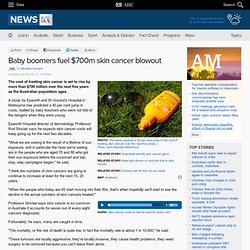
A study by Epworth and St Vincent's Hospital in Melbourne has predicted a 40 per cent jump in costs, fuelled by baby boomers who were not told of the dangers when they were young. Epworth Hospital director of dermatology Professor Rod Sinclair says he expects skin cancer costs will keep going up for the next two decades. "What we are seeing is the result of a lifetime of sun exposure, and in particular the rises we're seeing are in the people who are aged 70 and 80 who got their sun exposure before the sunsmart and slip, slop, slap campaigns began," he said.
"I think the numbers of skin cancers are going to continue to increase at least for the next 15, 20 years. More Australians seeking treatment for alcohol use. Increasing numbers of Australians are using drug treatment services for alcohol use, according to a report released today by the Australian Institute of Health and Welfare (AIHW).

Alcohol and other drug treatment services in Australia 2009-10: report on the National Minimum Data Set, shows that alcohol was the principal drug of concern reported in almost half (48%) of the 147,000 community-based drug treatment episodes provided across Australia in 2009–10. ‘This is the highest proportion of treatment episodes for alcohol use since the data collection began in 2001–02,’ said AIHW spokesperson Brent Diverty. Over two-thirds (69%) of all treatment episodes for alcohol were for males.
There were more males than females receiving treatment for all principal drugs of concern except benzodiazepines. ‘Alcohol was the most frequently reported principal drug of concern for all age groups, except for 10–19 year olds, where cannabis was more common,’ Mr Diverty said. The top five ways Australians die - Health & Wellbeing. By Cathy Johnson Did you know roughly 147,000 or so Australians die each year?
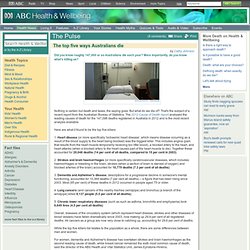
Replacing juice with water, fruits, and vegetables in afterschool programs cuts calories. September 17, 2012 — One in three U.S. children are overweight or obese, and growing evidence points to the empty calories they consume from sugary beverages as a substantial part of the problem.
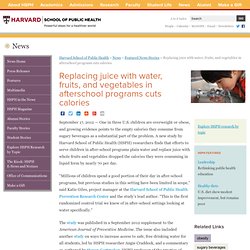
A new study by Harvard School of Public Health (HSPH) researchers finds that efforts to serve children in after-school programs plain water and replace juice with whole fruits and vegetables dropped the calories they were consuming in liquid form by nearly 70 per day. “Millions of children spend a good portion of their day in after-school programs, but previous studies in this setting have been limited in scope,” said Katie Giles, project manager at the Harvard School of Public Health Prevention Research Center and the study’s lead author. “This is the first randomized control trial we know of in after-school settings looking at water specifically.” The study was published in a September 2012 supplement to the American Journal of Preventive Medicine. —Amy Roeder photo: iStockphoto.com/CraigRJD. HSC PDHPE Core 1 - Identifying Health Priorities (SJP, Prevalence, Costs to Ind. and Comm. etc.)
Lifestyle secrets of the world's healthiest countries. Weight of the world.
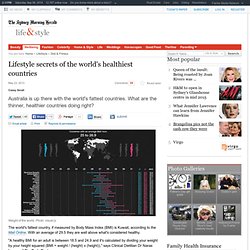
Photo: visual.ly The world's fattest country, if measured by Body Mass Index (BMI) is Kuwait, according to the Mail Online. With an average of 29.5 they are well above what's considered healthy. "A healthy BMI for an adult is between 18.5 and 24.9 and it's calculated by dividing your weight by your height squared (BMI = weight / (height) x (height))," says Clinical Dietitian Dr Naras Lapsys of The Body Doctor. What motivates you? - Quiz - Quizzes & Tools - Health & Wellbeing. By Andrew Cate Do you find it hard to stay motivated when it comes to looking after your health?
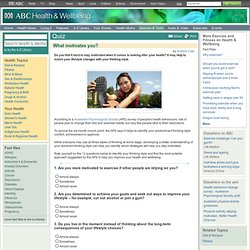
It may help to match your lifestyle changes with your thinking style. [Image source: iStockphoto] According to a Australian Psychological Society (APS) survey of people's health behaviours, lots of people plan to change their diet and exercise habits, but very few people stick to their resolutions. To survive the six-month crunch point, the APS says it helps to identify your predominant thinking style: comfort, achievement or approval.
Lifting an unfair burden from Generation Next. 22 per cent ... the proportion of Australian schoolchildren who are overweight or obese.
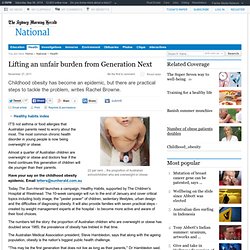
Healthy habits index IT'S not asthma or food allergies that Australian parents need to worry about the most. The most common chronic health disorder in young people is now being overweight or obese. Almost a quarter of Australian children are overweight or obese and doctors fear if the trend continues this generation of children will die younger than their parents. Have your say on the childhood obesity epidemic. Risk of early death from smoking more severe than thought, Australian study reveals. By Nonee Walsh Updated The risk of premature death from smoking is much more severe than previously thought for both light and heavy smokers, a large Australian study has revealed.

The study found that two thirds of deaths in current smokers can be attributed to tobacco use. Professor Emily Banks from the Australian National University led the study, which followed 200,000 people over four years. I Am Anxiety. Diabetes will soon be Australia's number one killer. Sugar shock: Diabetes will soon be Australia's number one killer. Photo: Rowena Dennis Going blind.
Getting your leg cut off. Kidneys packing up. Dying of a heart attack. This disease is big. It's a public health time bomb. Taking control: HSC student Taylor Eddy was diagnosed with type-2 diabetes last year. Put simply, diabetes is a chronic condition in which a person has high blood sugar. Cervical cancer rates at all-time low. Latest figures released in a report today by the Australian Institute of Health and Welfare (AIHW) show the incidence of cervical cancer among Australian women remains at an historic low since 2002.
The report, Cervical screening in Australia 2008–2009, shows there were 9 new cases of cervical cancer per 100,000 women aged 20–69 in 2007, with mortality at 2 deaths per 100,000 women. Incidence and mortality have both halved since the introduction of the National Cervical Screening Program (NCSP) in 1991. For women aged 20–69 years, incidence decreased from 19.0 new cases per 100,000 women in 1982 (the first year for which data are available) to 17.8 in 1990. Incidence decreased more sharply after that year to reach a plateau of 9 new cases per 100,000 women between 2002 and 2007. Mortality from cervical cancer has decreased more or less steadily since 1982, when the rate was 5.5 deaths per 100,000 women down to 1.9 deaths per 100,000 women in 2007.
YourHealth - New tobacco graphic health warnings. The key features of the Standard includes an increase in the size of graphic health warnings to cover at least 75 per cent of the front surface of most tobacco product packaging to convey a consistent public health message on the most visible surface of the package. The Standard maintains the size of 90 per cent of the back surface for cigarette packaging but requires an increase to 75 per cent of the back surface of most other tobacco products. The policy underpinning the Standard has been informed by consumer research on graphic health warnings and plain packaging.
Plain packaging. World watching cigarette packaging case The High Court's decision to uphold world-first plain packaging laws will be closely watched by health regulators around the globe. 15, 2012 The federal government has secured a big win over big tobacco with the High Court ruling Labor's world-first plain packaging laws are constitutionally valid. The decision is expected to have significant influence globally with both the United Kingdom and New Zealand considering plain packaging. Attorney-General Nicola Roxon with examples of the tobacco plain packaging and warning signs. Health experts have hailed the decision as a major victory for global health. More Australians seeking treatment for alcohol use. Skin cancer costs set to jump - ABC News.
Cervical cancer rates at all-time low. Why Do Kids Gain So Much Weight Between First and Third Grade? What happens to kids between first and third grades? They discover chapter books. They tackle multidigit subtraction. And they gain more weight than at any other point in elementary or middle school. Research published Monday in the journal Pediatrics finds that the largest weight gains are occurring at what researchers call a “critical time” in early elementary school, with the most significant leap — a 5.8% increase in body-mass index (BMI) — taking place between first and third grades.
SPECIAL: Is There an Obesity ‘Tipping Point’ in Infancy? To account for the scale-tipping, kids at this age must either be eating more or exercising less — or some combination of the two. To construct BMI percentiles, researchers looked at data from about 4,200 white, nearly 700 black, and more than 1,000 Hispanic kindergarteners, tracking their height and weight for nine years. MORE: If Your Kids Don’t Want to Eat, Don’t Sweat It. PDHPE - Epidemiology. I Am Anxiety. PDHPE - The Chaos of Cancer. Australian Guide to Healthy Eating. Jump to Navigation <div id="noJava">You have disabled JavaScript in your browser.
The young epidemic: Type 2 Diabetes in children. NSW Ministry of Health. New dietary guidelines to fight obesity [video] More Australians seeking treatment for alcohol use. Alcohol and teens: a dilemma for parents - Health & Wellbeing. Cervical cancer rates at all-time low. Skin cancer costs set to jump - ABC News. Lifestyle secrets of the world's healthiest countries. Chronic disease risks embedded in Aussie lifestyle. Most Australians have at least one preventable risk factor for chronic disease, according to a new report released today by the Australian Institute of Health and Welfare (AIHW). The report, Risk factors contributing to chronic disease, provides a comprehensive picture of the lifestyle behaviours of Australians that can contribute to chronic diseases such as arthritis, Type 2 diabetes, depression, asthma and osteoporosis. Diet is a very common risk factor for chronic disease, with over 90% of Australians failing to consume the recommended amounts of vegetables each day, and only half consuming enough fruit.
ATSI. PDHPE - Epidemiology. PDHPE - The Chaos of Cancer. PDHPE - Epidemiology. Increase in Melanoma Skin Cancer NOT Caused by Sun Exposure. Risk of early death from smoking more severe than thought, Australian study reveals.